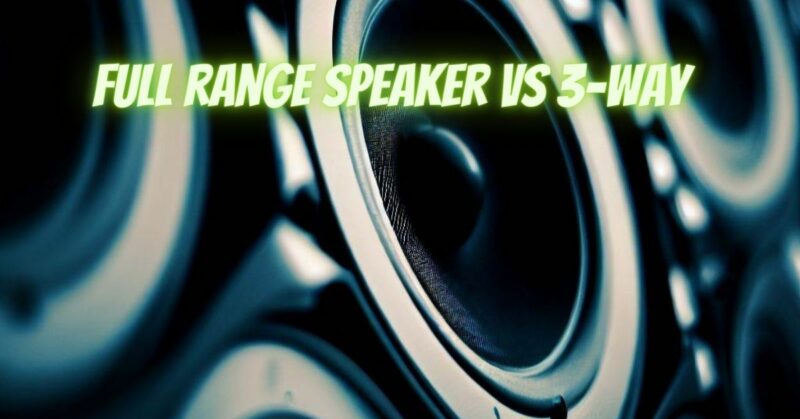When it comes to choosing speakers for your audio setup, understanding the various types and configurations available is crucial to achieving the desired sound reproduction. Two common speaker designs are full range speakers and 3-way speakers, each with its own characteristics and advantages. In this article, we will explore the differences between full range speakers and 3-way speakers, helping you make an informed decision based on your audio needs and preferences.
Full Range Speakers:
Full range speakers, as the name suggests, are designed to reproduce a wide range of frequencies, typically covering the entire audible spectrum from low to high frequencies. They are designed to handle the full frequency range without the need for additional drivers or components. Full range speakers often feature a single driver or a coaxial arrangement, where the tweeter is mounted within the woofer to create a compact and integrated design. They are known for their simplicity, efficiency, and ability to provide a balanced and coherent sound reproduction across the frequency spectrum.
3-Way Speakers:
On the other hand, 3-way speakers employ a more complex driver configuration to divide the audio signal into three frequency bands: low, mid-range, and high frequencies. They typically consist of a dedicated woofer for low frequencies, a mid-range driver for mid-range frequencies, and a tweeter for high frequencies. The crossover network within the speaker helps distribute the appropriate frequencies to each driver, ensuring optimal performance. 3-way speakers are designed to deliver enhanced clarity, separation, and detail across the different frequency ranges, providing a more specialized and nuanced audio reproduction.
Key Differences:
- Frequency Range: Full range speakers aim to reproduce the entire frequency spectrum, from lows to highs, within a single driver or coaxial design. In contrast, 3-way speakers divide the frequency range among separate drivers, allowing each driver to focus on its dedicated frequency band.
- Sound Reproduction: Full range speakers provide a more cohesive and integrated sound, with a focus on overall balance and tonal accuracy. 3-way speakers, with their dedicated drivers, offer enhanced detail, imaging, and separation, allowing for a more precise and immersive audio experience.
- Complexity and Size: Full range speakers are often simpler in design and compact in size due to their single driver or coaxial arrangement. 3-way speakers require additional drivers and components, which can result in larger speaker enclosures.
- Application and Usage: Full range speakers are well-suited for applications where simplicity, efficiency, and balanced sound reproduction are desired. They can be a great choice for smaller listening spaces or setups where space is limited. 3-way speakers are preferred in setups where detailed and accurate audio reproduction is crucial, such as home theaters or dedicated listening rooms.
| Feature | Full Range Speakers | 3-Way Speakers |
|---|---|---|
| Drivers | One | Three |
| Frequency range | 20 Hz to 20 kHz | 20 Hz to 20 kHz |
| Woofer size | Typically 4 inches to 8 inches in diameter | Typically 4 inches to 6 inches in diameter |
| Midrange size | – | Typically 3 inches to 6 inches in diameter |
| Tweeter size | – | Typically 1 inch to 2 inches in diameter |
| Power output | Typically 10 to 100 watts | Typically 10 to 50 watts |
| Purpose | To reproduce the full range of frequencies with ease of use | To reproduce the full range of frequencies with clarity and accuracy |
Conclusion:
Choosing between a full range speaker and a 3-way speaker depends on your specific audio requirements, listening preferences, and the intended usage of the speakers. Full range speakers offer simplicity, efficiency, and balanced sound reproduction across the frequency spectrum, while 3-way speakers provide enhanced detail, imaging, and separation through their dedicated drivers. Consider factors such as your listening environment, the type of content you enjoy, and your desired audio experience to make an informed decision that suits your needs.


